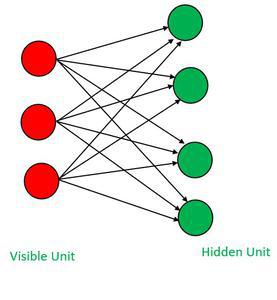
|
|
Restricted Boltzmann Machine (RBM) is a type of artificial neural network that is used for unsupervised learning and generative modeling. They follow the rules of energy minimization and are quite similar to probabilistic graphical models. Hopfield networks, which store memories, served as the basis for RBMs’ initial design, which was then modified to include hidden layers for the generative modeling of data. RBMs are frequently used for dimensionality reduction and unsupervised modeling, Although they can be modified for supervised modeling. But prior to supervised training, RBMs frequently go through an unsupervised pretraining period because of their innate properties. It has been discovered that this pretraining procedure, which involves training the RBM without labeled data, is very advantageous for future supervised learning. RBMs thus had a significant influence on the motivation for and acceptance of pretraining in deep learning models. An RBM’s training procedure is very different from a conventional feed-forward network’s. Backpropagation cannot be used to directly train RBMs; instead, Monte Carlo sampling methods must be used. Contrastive divergence is the RBM training algorithm most frequently used. Through sampling and comparison with the original input, this technique iteratively approximates the gradient of the RBM’s parameters. Restricted Boltzmann Machine Model Architecture:RBMs are two-layer generative neural network models. It is made up of a visible layer and a hidden layer with stochastic binary units. RBMs learn to capture patterns in input data by minimizing an energy function. They employ unsupervised learning and can be used for tasks such as feature learning, dimensionality reduction, and collaborative filtering. RBMs utilize a sampling method, like Gibbs sampling, to activate units probabilistically based on the energy function. Through training, RBMs adjust weights and biases to reconstruct observed data and generate plausible samples, making them effective for probabilistic modeling and generative tasks. It consists of two main layers named visible layer and hidden layer. Both layers contain a set of binary units.
 Restricted Boltzmann Machine Architecture Example:In this example, we will demonstrate the use of RBM features for digit classification using the MNIST (Modified National Institute of Standards and Technology) dataset, which consists of handwritten digits ranging from 0 to 9. Steps for the usage of an RBM in combination with logistic regression for classification tasks are:
Python3
Output: [BernoulliRBM] Iteration 1, pseudo-likelihood = -26.07, time = 0.03s
[BernoulliRBM] Iteration 2, pseudo-likelihood = -25.78, time = 0.03s
[BernoulliRBM] Iteration 3, pseudo-likelihood = -25.69, time = 0.03s
[BernoulliRBM] Iteration 4, pseudo-likelihood = -25.56, time = 0.06s
[BernoulliRBM] Iteration 5, pseudo-likelihood = -25.77, time = 0.03s
[BernoulliRBM] Iteration 6, pseudo-likelihood = -25.55, time = 0.03s
[BernoulliRBM] Iteration 7, pseudo-likelihood = -25.62, time = 0.04s
[BernoulliRBM] Iteration 8, pseudo-likelihood = -25.38, time = 0.04s
[BernoulliRBM] Iteration 9, pseudo-likelihood = -24.95, time = 0.03s
[BernoulliRBM] Iteration 10, pseudo-likelihood = -24.67, time = 0.03s
[BernoulliRBM] Iteration 11, pseudo-likelihood = -23.88, time = 0.03s
[BernoulliRBM] Iteration 12, pseudo-likelihood = -23.51, time = 0.04s
[BernoulliRBM] Iteration 13, pseudo-likelihood = -22.78, time = 0.04s
[BernoulliRBM] Iteration 14, pseudo-likelihood = -22.45, time = 0.04s
[BernoulliRBM] Iteration 15, pseudo-likelihood = -21.96, time = 0.04s
Classification Report :
precision recall f1-score support
0 0.91 0.94 0.93 33
1 0.66 0.75 0.70 28
2 0.72 0.85 0.78 33
3 0.76 0.82 0.79 34
4 0.94 1.00 0.97 46
5 0.83 0.64 0.72 47
6 0.97 0.94 0.96 35
7 0.81 0.85 0.83 34
8 0.78 0.47 0.58 30
9 0.60 0.68 0.64 40
accuracy 0.80 360
macro avg 0.80 0.79 0.79 360
weighted avg 0.80 0.80 0.79 360
Explanation: The output of the code will display the classification report. In this report, there are 4 cols with the name precision, recall, and F1-score for each digit class, indicating the accuracy and reliability of the model’s predictions and the support value represents the number of samples for each class in the test set. The model can achieve competitive performance in digit classification tasks by learning meaningful representations of the digit images using RBM features. Applications of Restricted Boltzmann MachineRestricted Boltzmann Machines (RBMs) have found numerous applications in various fields, some of which are:
|
Reffered: https://www.geeksforgeeks.org
| AI ML DS |
Type: | Geek |
Category: | Coding |
Sub Category: | Tutorial |
Uploaded by: | Admin |
Views: | 13 |